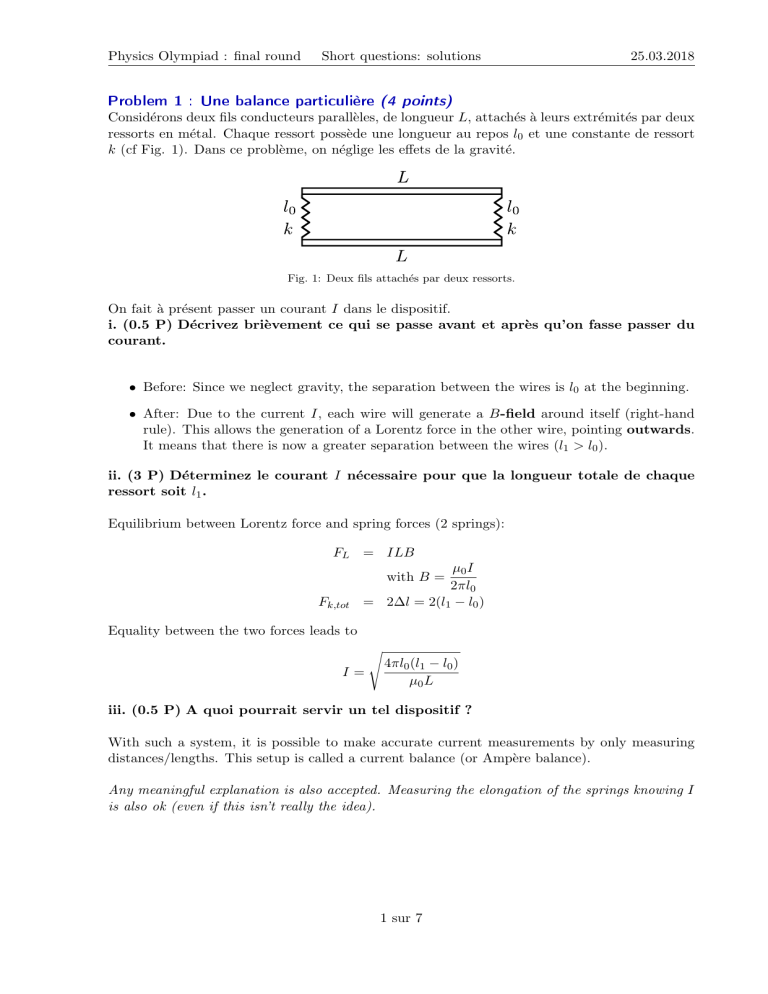
Physics Olympiad : final round Short questions: solutions 25.03.2018 Problem 1 : Une balance particulière (4 points) Considérons deux fils conducteurs parallèles, de longueur L, attachés à leurs extrémités par deux ressorts en métal. Chaque ressort possède une longueur au repos l0 et une constante de ressort k (cf Fig. 1). Dans ce problème, on néglige les effets de la gravité. Fig. 1: Deux fils attachés par deux ressorts. On fait à présent passer un courant I dans le dispositif. i. (0.5 P) Décrivez brièvement ce qui se passe avant et après qu’on fasse passer du courant. • Before: Since we neglect gravity, the separation between the wires is l0 at the beginning. • After: Due to the current I, each wire will generate a B-field around itself (right-hand rule). This allows the generation of a Lorentz force in the other wire, pointing outwards. It means that there is now a greater separation between the wires (l1 > l0 ). ii. (3 P) Déterminez le courant I nécessaire pour que la longueur totale de chaque ressort soit l1 . Equilibrium between Lorentz force and spring forces (2 springs): FL = ILB µ0 I 2πl0 = 2∆l = 2(l1 − l0 ) with B = Fk,tot Equality between the two forces leads to s I= 4πl0 (l1 − l0 ) µ0 L iii. (0.5 P) A quoi pourrait servir un tel dispositif ? With such a system, it is possible to make accurate current measurements by only measuring distances/lengths. This setup is called a current balance (or Ampère balance). Any meaningful explanation is also accepted. Measuring the elongation of the springs knowing I is also ok (even if this isn’t really the idea). 1 sur 7 Physics Olympiad : final round Short questions: solutions 25.03.2018 (4 points) Une balance est à l’équilibre avec une boule de plomb (ρPb = 11.3 × 103 kg·m−3 ) accrochée à un bras et une boule d’or (ρAu = 19.3 × 103 kg·m−3 ) à l’autre, les deux bras ont la même longueur. Problem 2 : Une autre balance i. (2.5 P) On plonge chacune des boules dans des récipients d’eau; de quel côté la balance penche-t-elle ? Justifiez votre réponse. • Before: Both balls are at equilibrium. Since both arms of the balance are equally long, this means that m1 = m2 ∼ ρAu VAu = ρP b VP b Since ρAu > ρP b , one has VAu < VP b • After: As soon as the balls are submerged into water, there is the appearance of a buyancy force of the form ρwater Vi g Since VAu < VP b ⇒ ρwater VAu g < ρwater VP b g, the buyancy force on the lead ball is greater, which means that the lead ball is higher than the gold one. ii. (1.5 P) Quelle devrait être la densité du liquide qui remplacerait l’eau dans le récipient du côté duquel la balance penche pour conserver l’équilibre de cette dernière ? In order to have both balls at the same height, both buyancy forces must be the same: ρnew VAu g = ρwater VP b g VP b ρAu ρnew = ρwater = ρwater VAu ρP b 19.3 × 103 kg·m−3 ≈ 103 kg·m−3 · = 1.7 × 103 kg·m−3 11.3 × 103 kg·m−3 2 sur 7 Physics Olympiad : final round Short questions: solutions 25.03.2018 (4 points) Deux billes homogènes et identiques roulent l’une derrière l’autre avec la même vitesse v0 sur une portion horizontale d’un circuit pour billes; elles sont séparées par une distance d0 . Après le passage dans un toboggan, elles se retrouvent à nouveau sur une portion horizontale du circuit, mais à une hauteur ∆h plus bas. Problem 3 : Circuit pour billes Quelle est alors la distance entre les billes, i. (2 P) lorsqu’elles glissent sans frottement ? Energy conservation for one marble: 1 mv 2 + mg∆h 2 0 = 1 mv 2 2 1q ⇒ v1 = v02 + 2gh The distances between the marbles can be characterized by a time intervall ∆t: d0 = v0 ∆t d0 d1 = v1 ∆t = v1 v0 s 2gh = d0 1 + 2 v0 Last step: They can use alternative expressions to get d1 . ii. (2 P) lorsqu’elles roulent sans glisser ? This time, we have a rotational kinetical energy to take into account. The total kinetical energy is: 1 1 Ekin,tot = mv02 + Iω02 2 2 with I = ω = 2 2 mr , 5 v0 , (no sliding condition) r and thus 1 1 7 Ekin,tot = mv02 + mv02 = mv02 2 5 10 The rest of the calculation is exactly the same as in the previous part, only the kinetical energy is new, and one finally finds r 10 v1 = v02 + gh 7 s 10gh d1 = d0 1 + 7v02 3 sur 7 Physics Olympiad : final round Short questions: solutions 25.03.2018 (4 points) Sur la figure Fig. 2, on peut voir deux condensateurs montés en série. La partie intermédiaire verticale de longueur b peut être retirée. Chaque plaque d’un condensateur possède une surface S. On applique une tension U constante entre les points A et B. Problem 4 : Condensateurs en série Fig. 2: Deux condensateurs plans. i. (4 P) De quelle manière est modifiée l’énergie stockée dans les condensateurs lorsqu’on retire la partie intermédiaire ? Exprimez votre réponse en fonction des grandeurs données. Let’s call d1 and d2 the separation between the plates of each condensator. Then, each condensator has a capacity S C i = ε0 di Since both condensators are in series, the total capacity is Ctot = C1−1 + C2−1 −1 = ε0 S d1 + d2 Note that d1 + d2 = a − b. The total energy stored in the condensators is then: 1 ε0 SU 2 E = Ctot U 2 = 2 2(a − b) Removing the middle part means setting b = 0. The energy variation between both situations is thus ε0 SU 2 ε0 SU 2 b ε0 SU 2 − = ∆E = 2(a − b) 2a 2a(a − b) 4 sur 7 Physics Olympiad : final round Short questions: solutions 25.03.2018 (4 points) A l’intérieur d’un conteneur sphérique, on maintient une température constante Tin . La paroi intérieure se trouve à une distance rin du centre de la sphère. La température mesurée sur la paroi extérieure, correspondant au rayon rout > rin , est de Tout . Le matériel isolant entre les deux parois possède une conductivité thermique λ. Problem 5 : Conduction thermique d'un conteneur sphérique i. (4 P) Quelle est la puissance de transfert thermique Q̇ de l’intérieur de la sphère vers l’extérieur ? Exprimez votre résultat en fonction des constantes données, où les températures sont exprimées en [K], les longueurs en [m], la conductivité thermique en [W/(m·K)] et la puissance de transfert thermique en [W]. Z Z xα+1 α Indication : x dx = + K, α 6= −1 x−1 dx = ln |x| + K α+1 The thermal transfer power can be written as ∆T ∆r dT = λ4πr2 dr Q̇(r) = λS(r) and is constant on every shell of radius r. By rearranging the expression, one can easily perform an integration: Z dT = dT = Tout Tin Tout − Tin = and thus Q̇ = Q̇ dr 4πλ r2 Z rout Q̇ dr 4πλ r2 rin Q̇ 1 1 − + 4πλ rout rin 4πλ(Tout − Tin ) 1 1 + rin rout 5 sur 7 Physics Olympiad : final round Short questions: solutions 25.03.2018 (4 points) Une exoplanète, Kepler-22b, orbite autour de l’étoile Kepler-22 (MK = 0.97Msoleil , RK = 0.979Rsoleil ). L’orbite de cette planète est telle que vue de la Terre, elle passe devant son étoile. Lorsqu’un tel transit se produit, on peut ainsi observer une diminution de luminosité. Le graphe suivant montre la luminosité mesurée durant le transit de Kepler-22b : Problem 6 : Exoplanète i. (2.5 P) Calculez le rayon Rp de la planète. Indication : Msoleil ≈ 1.989 × 1030 kg, Rsoleil ≈ 6.955 × 105 km. The power radiated by the star is given by the Stefan-Boltzmann law: L = σAT 4 where the surface directed towards the Earth is, if there is no planet inbetween: 2 A = πRK Since the distance between the planet and the star is much bigger than the distance to the Earth, the radiating surface during the transit is given by 2 AT = πRK − πRp2 and thus we have the ratio 2 − R2 )T 4 Rp2 σπ(RK LT p = 1 − = 2 T4 2 L σπRK RK R2 The relative flux deviation during the transit, ∆F = R2p allows to determine the radius of the K planet: √ Rp = ∆F RK From the graph, we have ∆F ≈ 4.5 × 10−4 , which gives us Rp = 0.02Rsun ≈ 14 434 km L’intervalle de temps ∆T entre deux chute de luminosité est de 289.9 jours. ii. (1.5 P) Calculez le demi-grand axe de la trajectoire de la planète. 6 sur 7 Physics Olympiad : final round Short questions: solutions 25.03.2018 The period ∆T between two luminosity variations corresponds to the period T of the planet around the star. The 3rd Kepler law gives us a3 T2 GMK 4π 2 GMK T 1/3 a = 4π 2 = With the mass of the Sun of MSun ≈ 1.99 × 1030 kg, one finds approximately a ≈ 1.27 × 108 km 7 sur 7

